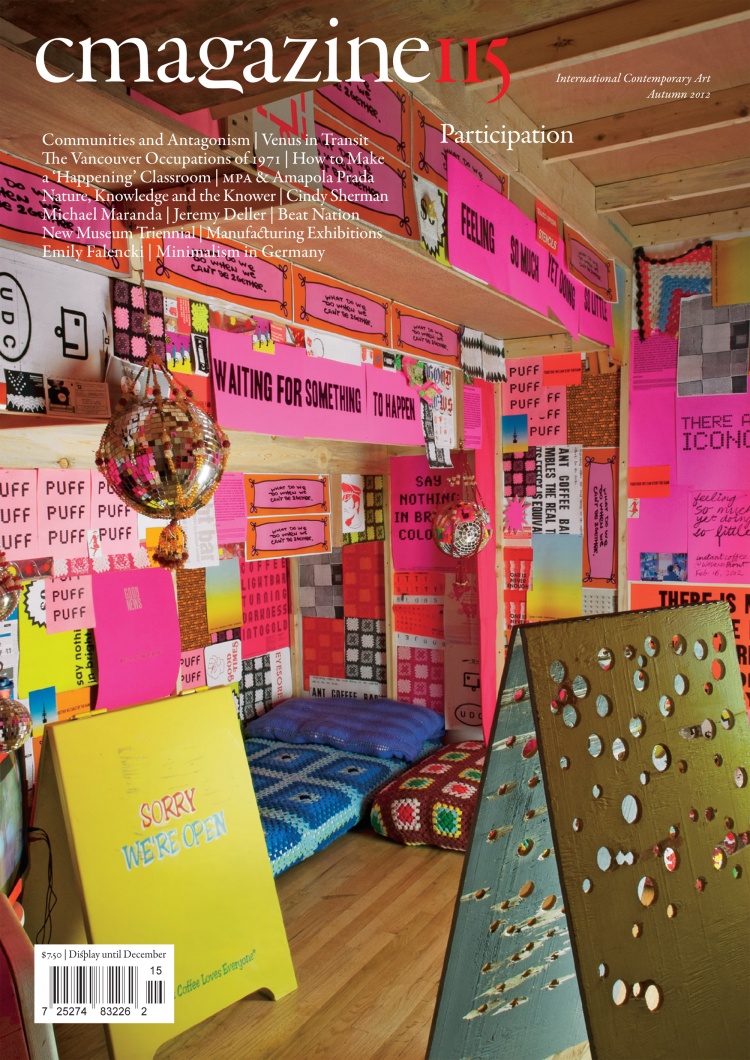View full issue here.
C Magazine Issue 115: Participation
Fall 2012
Participation
Over the past year, C has examined themes that have included Exhibition Practices, Memory, Men, and now, in this issue, Participation. However, our interest in these topics never ends once each respective issue has gone to press. For instance, in her short text in this issue, “Venus in Transit,” Corrine Fitzpatrick responds to the Men issue in describing the ongoing “rethinking and reframing” of masculinity: “A conclusion is a comma, not a full stop. A comma begets a new clause.” While Fitzpatrick refers here to masculinity, and more broadly to gender, she could also be describing our own evolving editorial strategy in relationship to thematic issues. In various ways, ideas from previous issues continue on or re-emerge, evolving in conversation with our contributors and readers.
In this issue, several feature essays look at art practices that model, enact or represent forms of social or political participation. In “The Vancouver Occupations of 1971,” Leah Modigliani looks at how Ken Lum, Stan Douglas and Mark Tribe take the history of the New Left and 60s and 70s radical subcultures as subject matter for their work, through installations such as Lum’s from shangri-la to shangri-la(2010), Douglas’ Abbott & Cordova, 7 August, 1971 (2008), and Tribe’s Port Huron Project (2006-2009). Contrasting the actual Vancouver Occupations of 1971 with their contemporary representation by artists, Modigliani employs Walter Benjamin’s idea of Left-Wing Melancholy to raise important questions about how these artworks engage viewers as political agents.
In “Communities and Antagonism: Looking for Art in All the Wrong Places,” Amy Fung surveys 12 years of socially engaged practice by the Toronto and Vancouver-based collective Instant Coffee, while also discussing works by similar organizations, such as Mammalian Diving Reflex. Since the 90s, Instant Coffee has staged events and created architectural environments that facilitate different forms of social participation and conviviality, but which often also perform a service function. For example, with Light Bar, a work they mounted in Vancouver during the 2010 Winter Olympics, participants could combat seasonal affective disorder with full-spectrum lighting, enjoy light shows and watch projected lectures. In Fung’s essay, she interviews the current Vancouver members of Instant Coffee and proposes an alternative to the ideal, harmonious community of likeminded people through the idea of “uncommon-unity” where forms of social participation not only bring people together who didn’t have anything in common prior to their involvement in an art event, but which can also produce productive forms of antagonism.
In her essay “Push and Pull: How to Make a ‘Happening Classroom,’” Vesna Krstich writes about projects where artists – including Allan Kaprow, Grzegorz Kowalski, Pawel Althamer and Artur Zmijewski, among others – have attempted to fuse ideas and methods from Fluxus and performance art with pedagogical practice. Through the use of instructional scores and by applying formal structures to social relations, they have created participatory events that can sometimes invert existing social hierarchies and enact forms of play and poetic gesture within traditional school curricula. Tracing the history of the use of performance instructions and conceptual art in classroom environments since the early 60s, Krstich presents an expanded discussion of these practices as part of experiential and collaborative learning.
This issue also revisits the theme of Memory — the focus of C113 — with Rachel Anne Farquharson’s essay, “The Present as Enduring Past: Recollecting Through the Works of Kerry Tribe, Petrina Ng and Lindsay Seers.” Here, she looks at recent works by these artists in terms of how they help us to understand how contemporary media, such as film, reflects the structure and experience of human memory. Dealing with both “real” memories that are grounded in life experience, and fictional memories that are produced through images and popular culture, Farquharson explores how our sense of the present is structured by our own past and the stories of others, literally becoming present through forms of cognitive association.
Similarly, in the aforementioned essay “Venus in Transit,” Corrine Fitzpatrick expands upon ideas that appeared in the most recent issue. She writes: “Masculinity is a muscle that our culture can’t relax. Its sinews are grammatical, sartorial, religious, popular. Acts of resistance too often replenish the strength of the dominant force.” For me, reflecting on the Men issue, it is difficult to know whether this particular issue of C Magazine has had the inadvertent effect of further entrenching the unequal power relations that pervade our culture and language or if it ever so modestly made a contribution to their undoing. In her essay, Fitzpatrick also describes MPA and Amapola Prada’s collaborative performance last November at Leo Koenig Inc. in New York City, as part of MPA’s highly acclaimed exhibition Directing Light Onto the Fist of Father. In the performance, titled Revolution. Two Marks in Rotation, the artists used steel scaffolding poles to break glass, smash holes in the walls, and engage the audience in a struggle for control over the gallery space. This piece invoked what Fitzpatrick describes as a “collective physical refusal” manifest in the audience’s reaction, as fearful and enraged audience members pushed back against the performers. Experienced by its viewers as a deeply affecting meditation on the dynamics of power and resistance, passivity and the shifting nature of power itself, documentation of this performance appears in the centrefold and inside back cover of this issue.
Over the next year, as C Magazine approaches its 30th anniversary — the first issue of C Magazine having been published in the winter of 1983/84 — we will be delving into past issues of the magazine and exploring ways of making both new and archival content available through our website. Returning to the theme of Participation, we’re interested in how the print edition of C and its online version might intersect in ways that enable greater dialogue between the magazine and its readers, and how these two forms might evolve together.
